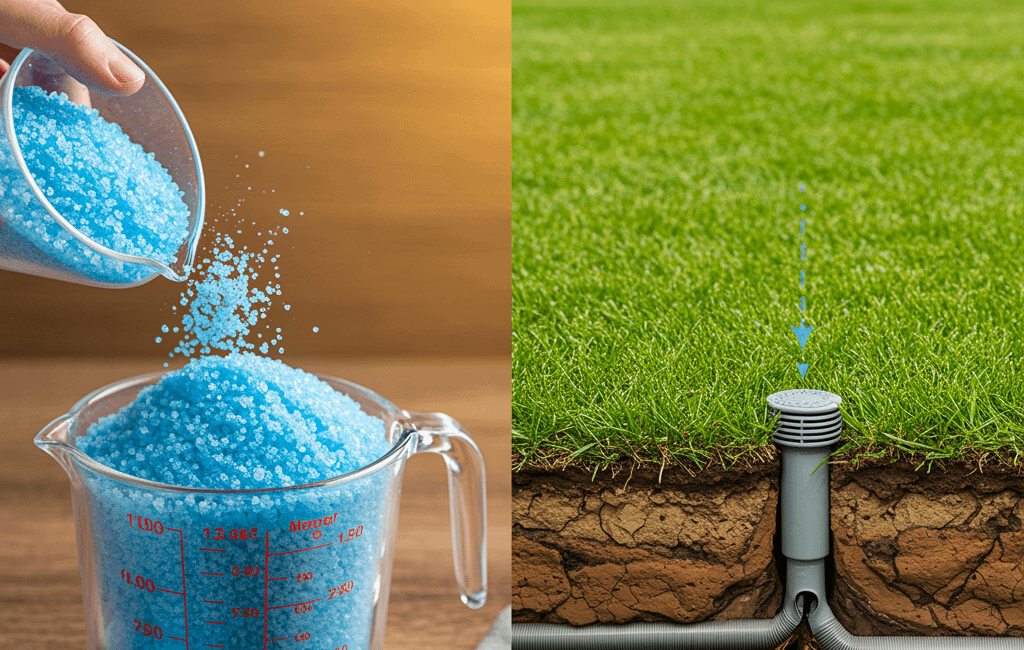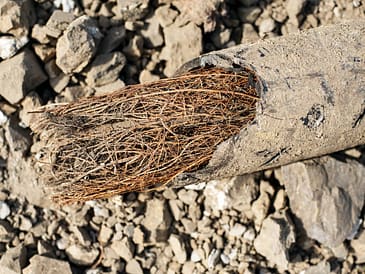The Complete Guide to Using Copper Sulfate for Septic System Root Control
Your septic system is backing up, strange odors are wafting from your yard, and you’re staring down a potential $15,000+ repair bill. But what if I told you that a simple $5 chemical sitting on most hardware store shelves could be the difference between a minor maintenance task and a financial disaster? That’s exactly what happened to Sarah Mitchell from Tennessee, who avoided a complete septic replacement using nothing more than copper sulfate and the right knowledge. Here’s everything you need to know about this septic system lifesaver.
Understanding the Hidden Enemy: Root Intrusion in Septic Systems
Before diving into how to use copper sulfate in septic system maintenance, let’s understand why this treatment becomes necessary. Tree and shrub roots are naturally drawn to the nutrient-rich environment of septic systems, particularly during dry seasons when moisture is scarce. These invasive roots can infiltrate even the smallest cracks in septic pipes, growing rapidly once they discover this water source.
The problem with septic system root intrusion isn’t just about blocked pipes. When roots establish themselves in your septic lines, they create a cascade of issues that can compromise your entire system’s functionality. They trap solid waste, reduce flow capacity, and can even cause pipe collapse in severe cases.
Expert Insight from Dr. James Patterson, Environmental Engineering Specialist:
“Root intrusion is responsible for approximately 65% of septic system failures in residential properties. The key to effective management is early intervention. Copper sulfate, when used correctly, provides a cost-effective solution that can extend system life by decades while maintaining environmental safety standards.”
What is Copper Sulfate and How Does It Work?
Copper sulfate for root control has been used in septic maintenance for over 50 years, making it one of the most time-tested solutions available. Chemically known as copper(II) sulfate pentahydrate (CuSO₄·5H₂O), this bright blue crystalline compound works as a selective herbicide that targets root systems without harming the beneficial bacteria essential for septic system operation.
When copper sulfate comes into contact with roots, it disrupts their cellular structure, causing them to die and decompose naturally. This process, known as desiccation, effectively eliminates existing root intrusions while creating a temporary barrier that discourages new root growth in treated areas.
The beauty of copper sulfate septic treatment lies in its selectivity. While it’s highly effective against plant roots, it doesn’t interfere with the anaerobic bacteria responsible for breaking down waste in your septic tank. This makes it an ideal choice for homeowners who want to address root problems without compromising their system’s biological processes.
Signs Your Septic System Needs Copper Sulfate Treatment
Recognizing the early warning signs of root intrusion can save you thousands in repair costs. Here are the key indicators that suggest you might need septic system root removal using copper sulfate:
Slow Draining Fixtures: When roots begin blocking your septic lines, you’ll notice toilets, sinks, and tubs draining more slowly than usual. This often starts subtly but progressively worsens as root masses expand.
Recurring Backups: If you’re experiencing frequent septic backups despite regular pumping, root intrusion is likely the culprit. Unlike other septic issues, root-related backups tend to occur in patterns, often coinciding with seasonal growth cycles.
Lush Vegetation Patterns: Unusually green or fast-growing vegetation above your septic lines often indicates root infiltration. These plants are essentially “feeding” off your septic system’s nutrients through their invasive root systems.
Professional Tip from Mike Rodriguez, Licensed Septic Contractor:
“I always tell my clients to watch for the ‘Christmas tree pattern’ of vegetation growth. When you see abnormally green grass forming triangle or line patterns in your yard, it’s almost always a sign of septic line infiltration. Early copper sulfate treatment at this stage can prevent what would otherwise become a $8,000-$12,000 repair job.”
Step-by-Step Guide: How to Apply Copper Sulfate in Your Septic System
Now let’s get into the practical application of copper sulfate application septic. This process requires careful attention to detail and proper safety precautions to ensure effectiveness while protecting your system’s beneficial bacteria.
Materials Needed:
Before beginning your DIY septic root treatment, gather these essential materials:
- 2-4 pounds of copper sulfate crystals (available at most hardware stores)
- Rubber gloves and safety glasses
- Dust mask or respirator
- Large bucket for mixing
- Wooden stirring stick
- Measuring cup
- Funnel (optional but recommended)
Application Process:
Step 1: Safety First
Put on all safety equipment before handling copper sulfate. While relatively safe when used properly, copper sulfate can cause skin and eye irritation. Work in a well-ventilated area and avoid inhaling dust particles.
Step 2: Calculate the Correct Dosage
For most residential septic systems, use 2 pounds of copper sulfate per 300 feet of pipe. If you’re unsure about your system’s pipe length, start with 2 pounds for a standard system and adjust based on results.
Step 3: Prepare the Solution
Mix the copper sulfate with warm water in your bucket, using approximately 1 gallon of water per pound of crystals. Stir until completely dissolved. The solution should have a bright blue color when properly mixed.
Step 4: Application Timing
Apply the solution during a period of low water usage, ideally before bedtime when the family won’t be using water for 6-8 hours. This allows the copper sulfate to remain in contact with roots longer for maximum effectiveness.
Step 5: Introduce the Solution
Pour the solution down your toilet in small amounts, flushing between each pour. This method ensures even distribution throughout your septic system while maintaining proper dilution ratios.
Safety Warning from Lisa Chen, Environmental Health Specialist:
“Never apply copper sulfate during periods of heavy water usage or immediately before pumping your septic tank. The treatment needs time to work, and proper contact time is crucial for both effectiveness and safety. Always follow manufacturer instructions and local regulations regarding copper sulfate use.”
Copper Sulfate Dosage Guidelines for Different System Sizes
Understanding proper copper sulfate dosage septic is crucial for effective treatment without environmental harm. The dosage varies based on your system size, pipe length, and severity of root intrusion.
Small Systems (1-2 bedrooms): Use 1-2 pounds of copper sulfate every 6-12 months. These systems typically have 200-300 feet of pipe and require less aggressive treatment.
Medium Systems (3-4 bedrooms): Apply 2-3 pounds every 6-12 months. Most suburban homes fall into this category, with pipe lengths ranging from 300-500 feet.
Large Systems (5+ bedrooms): Use 3-4 pounds every 6-12 months. These systems often have complex distribution networks requiring more comprehensive treatment.
For severe root intrusion problems, you may need to repeat treatments every 3-4 months initially, then transition to a maintenance schedule once roots are under control. Always monitor your system’s response and adjust accordingly.
Environmental Considerations and Safety Precautions
While copper sulfate environmental impact is generally minimal when used correctly, responsible application is essential. Copper is a heavy metal that can accumulate in soil over time, so following proper guidelines protects both your property and the broader environment.
Groundwater Protection: Never exceed recommended dosages, as excess copper can leach into groundwater supplies. Most properly functioning septic systems effectively contain and process copper sulfate when used as directed.
Surface Water Concerns: If your property has wells, streams, or ponds within 100 feet of your septic system, consult with local environmental authorities before using copper sulfate. Some areas have specific restrictions on heavy metal applications near water sources.
Soil pH Considerations: Copper sulfate can lower soil pH over time. If you’re using it regularly, consider periodic soil testing and pH adjustment if necessary to maintain healthy soil conditions around your septic system.
Environmental Perspective from Dr. Sarah Williams, Soil Science Researcher:
“When used responsibly, copper sulfate presents minimal environmental risk in septic applications. The key is adherence to dosage guidelines and treatment frequency. I recommend soil testing every 2-3 years for properties using regular copper sulfate treatments to monitor copper levels and soil health.”
Alternative Root Control Methods vs. Copper Sulfate
While copper sulfate remains the gold standard for septic root control methods, understanding your options helps you make informed decisions about your system’s maintenance.
Mechanical Root Removal: Professional rooter services can physically remove roots from septic lines, but this is typically a temporary solution. Costs range from $200-$800, but roots often return within 6-18 months without chemical treatment.
Foam Root Killers: These products offer easier application than copper sulfate but often cost 3-4 times more for comparable effectiveness. They’re ideal for homeowners uncomfortable with handling crystalline chemicals.
Enzymatic Treatments: Biological root control products work slowly but offer environmentally friendly alternatives. However, they typically require 3-6 months to show results and may not be effective against established root systems.
Physical Barriers: Installing root barriers around septic lines prevents intrusion but requires significant excavation and expense, typically costing $2,000-$5,000 for comprehensive protection.
Maintaining Your Septic System After Copper Sulfate Treatment
Successful septic system maintenance after copper sulfate requires ongoing attention to both chemical and biological aspects of your system. The goal is maintaining root control while preserving beneficial bacterial populations.
Monitoring Treatment Effectiveness: Within 2-4 weeks of treatment, you should notice improved drainage and reduced backup frequency. If problems persist, you may need additional treatment or professional inspection to identify other issues.
Bacterial Health Maintenance: While copper sulfate doesn’t significantly impact septic bacteria, supporting your system’s biological processes enhances overall effectiveness. Avoid excessive use of antibacterial products and maintain regular pumping schedules.
Preventive Landscaping: Strategic plant selection around your septic system reduces future root intrusion risk. Choose shallow-rooted plants and maintain appropriate distances between large trees and septic components.
When to Call Professionals vs. DIY Treatment
Understanding when to attempt DIY copper sulfate septic treatment versus calling professionals can save both money and potential system damage. Here’s a practical framework for making this decision.
DIY Appropriate Situations:
- Minor drainage slowdowns without complete blockages
- Preventive maintenance for systems with known root intrusion history
- Systems less than 15 years old with accessible cleanouts
- Homeowners comfortable with chemical handling and safety procedures
Professional Service Recommended:
- Complete system backups or overflows
- Systems with unknown pipe locations or configurations
- Properties with environmental sensitivities (wells, streams, protected areas)
- Situations requiring pipe inspection or damage assessment
Cost-Benefit Analysis from Tom Davidson, Septic System Consultant:
“I typically recommend DIY copper sulfate treatment for maintenance and minor issues. The $15-30 annual cost of materials versus $300-500 for professional root cutting services makes economic sense for most homeowners. However, if you’re seeing surface sewage or complete system failure, professional intervention is essential for proper diagnosis and repair.”
Troubleshooting Common Copper Sulfate Application Issues
Even with proper application, homeowners sometimes encounter challenges with copper sulfate septic problems. Understanding common issues and solutions ensures successful treatment outcomes.
Incomplete Dissolution: If copper sulfate crystals aren’t fully dissolving, try using warmer water and allowing more mixing time. Undissolved crystals can settle in pipe low points, reducing treatment effectiveness.
Blue Staining: Temporary blue discoloration in toilets or fixtures is normal after treatment. This typically fades within a few days as the copper sulfate moves through your system.
Continued Root Problems: If roots persist after 4-6 weeks, you may need to increase dosage or treatment frequency. However, always stay within recommended limits and consider professional inspection for severe cases.
System Odors: Temporary odors may occur as dead roots decompose. This is normal and should resolve within 2-3 weeks. Persistent odors may indicate other system issues requiring professional evaluation.
Long-term Benefits and Cost Analysis
The cost of copper sulfate for septic systems represents one of the best investments in home maintenance you can make. Let’s break down the numbers to understand the true value proposition.
Annual Treatment Costs: Regular copper sulfate treatments typically cost $15-30 per year in materials, assuming bi-annual applications for preventive maintenance.
Professional Service Comparison: Professional root cutting services range from $300-800 annually, making DIY copper sulfate treatment roughly 90% less expensive for routine maintenance.
Major Repair Avoidance: The average cost of septic system replacement ranges from $8,000-20,000, depending on system size and local conditions. Regular root control can extend system life by 10-15 years, providing substantial long-term savings.
Property Value Protection: A well-maintained septic system adds value to your property, while a failing system can significantly impact resale value and marketability.
Creating Your Copper Sulfate Treatment Schedule
Developing a systematic approach to septic root prevention with copper sulfate ensures consistent protection while avoiding over-treatment. Your schedule should account for local growing conditions, tree proximity, and system age.
New Systems (0-5 years): Annual preventive treatments during spring months when root growth is most active. This establishes early protection before root intrusion becomes established.
Mature Systems (5-15 years): Bi-annual treatments in spring and fall, coinciding with peak root activity periods. This schedule addresses both new growth and established root systems.
Older Systems (15+ years): May require quarterly treatments initially, transitioning to bi-annual maintenance once root problems are controlled. Older systems often have more pipe joints and potential infiltration points.
High-Risk Properties: Properties with extensive mature landscaping or known root intrusion history may benefit from quarterly preventive treatments, at least initially.
Seasonal Advice from Maria Gonzalez, Landscape-Septic Specialist:
“The best time for copper sulfate treatment is early spring, just before the growing season begins. This timing provides maximum effectiveness as roots become active but before they’ve established extensive new growth. Fall treatments work well in warmer climates where root activity continues longer into the year.”
Conclusion: Protecting Your Investment with Smart Septic Maintenance
Learning how to use copper sulfate in septic system maintenance empowers you to take control of one of your home’s most critical systems. The combination of low cost, proven effectiveness, and environmental safety makes copper sulfate treatment an essential tool in every homeowner’s maintenance arsenal.
Remember that successful septic system management requires a holistic approach. While copper sulfate effectively addresses root intrusion, it works best as part of a comprehensive maintenance strategy that includes regular pumping, careful water usage, and appropriate landscaping choices.
The $15-30 annual investment in copper sulfate treatment can literally save you tens of thousands in replacement costs while ensuring your family’s health and safety. More importantly, proactive maintenance prevents the stress and disruption that comes with septic system failures.
Whether you’re dealing with existing root problems or want to prevent future issues, copper sulfate offers a practical, cost-effective solution that puts you in control of your septic system’s health. Start with the guidelines provided here, monitor your system’s response, and adjust your treatment schedule based on results.
Your septic system is a significant investment in your property and quality of life. With proper copper sulfate treatment and ongoing maintenance, you can protect that investment for decades to come while avoiding the financial and practical nightmares of system failure.





